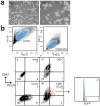Study of hepatitis C virus entry in genetically humanized mice
- PMID: 22687621
- PMCID: PMC3652663
- DOI: 10.1016/j.ymeth.2012.05.010
Study of hepatitis C virus entry in genetically humanized mice
Abstract
Approximately 2% of the world's population is chronically infected with hepatitis C virus (HCV). Chronic hepatitis C can culminate in end stage liver disease and liver cancer if the infection is untreated. Current therapy is only partially effective and a vaccine for HCV does not exist. Since the discovery of HCV as the etiologic agent causing hepatitis C several experimental tools have been developed which have improved our understanding of the viral life cycle and the interaction of HCV with human cells. However, it remains challenging to study HCV infection in its native liver environment given its narrow species tropism, limited to humans and chimpanzees. Mice can be rendered susceptible to HCV infection by transplanting human hepatocytes into immunocompromized liver injury strains. Such human liver chimeric mice are useful as a challenge model for human hepatotropic pathogens but their utility is hampered by their inability to mount functional immune responses and practical aspects including high costs, low throughput, and donor-to-donor variability. The barriers that restrict HCV species tropism are incompletely understood. We have previously shown that expression of human CD81 and human OCLN is required for HCV uptake into mouse cells. This led to the construction of a genetically humanized mouse model for HCV infection. Here, we provide a detailed protocol for the generation of these animals and highlight some of its applications for studying HCV biology and preclinical testing of drug and vaccine candidates.
Copyright © 2012 Elsevier Inc. All rights reserved.
Figures



Similar articles
-
Mice Expressing Minimally Humanized CD81 and Occludin Genes Support Hepatitis C Virus Uptake In Vivo.J Virol. 2017 Jan 31;91(4):e01799-16. doi: 10.1128/JVI.01799-16. Print 2017 Feb 15. J Virol. 2017. PMID: 27928007 Free PMC article.
-
Expanding the Host Range of Hepatitis C Virus through Viral Adaptation.mBio. 2016 Nov 8;7(6):e01915-16. doi: 10.1128/mBio.01915-16. mBio. 2016. PMID: 27834208 Free PMC article.
-
Completion of the entire hepatitis C virus life cycle in genetically humanized mice.Nature. 2013 Sep 12;501(7466):237-41. doi: 10.1038/nature12427. Epub 2013 Jul 31. Nature. 2013. PMID: 23903655 Free PMC article.
-
Animal Models Used in Hepatitis C Virus Research.Int J Mol Sci. 2020 May 29;21(11):3869. doi: 10.3390/ijms21113869. Int J Mol Sci. 2020. PMID: 32485887 Free PMC article. Review.
-
Generation of improved mouse models for the study of hepatitis C virus.Eur J Pharmacol. 2015 Jul 15;759:313-25. doi: 10.1016/j.ejphar.2015.03.022. Epub 2015 Mar 23. Eur J Pharmacol. 2015. PMID: 25814250 Review.
Cited by
-
Role of hypervariable region 1 for the interplay of hepatitis C virus with entry factors and lipoproteins.J Virol. 2014 Nov;88(21):12644-55. doi: 10.1128/JVI.01145-14. Epub 2014 Aug 20. J Virol. 2014. PMID: 25142595 Free PMC article.
-
The Strange, Expanding World of Animal Hepaciviruses.Annu Rev Virol. 2016 Sep 29;3(1):53-75. doi: 10.1146/annurev-virology-100114-055104. Annu Rev Virol. 2016. PMID: 27741408 Free PMC article. Review.
-
Broadly neutralizing antibodies abrogate established hepatitis C virus infection.Sci Transl Med. 2014 Sep 17;6(254):254ra129. doi: 10.1126/scitranslmed.3009512. Sci Transl Med. 2014. PMID: 25232181 Free PMC article.
-
New generation humanized mice for virus research: comparative aspects and future prospects.Virology. 2013 Jan 5;435(1):14-28. doi: 10.1016/j.virol.2012.10.007. Virology. 2013. PMID: 23217612 Free PMC article. Review.
-
Recapitulation of the hepatitis C virus life-cycle in engineered murine cell lines.Virology. 2013 Sep;444(1-2):1-11. doi: 10.1016/j.virol.2013.05.036. Epub 2013 Jun 16. Virology. 2013. PMID: 23777661 Free PMC article.
References
-
- Jacobson IM, McHutchison JG, Dusheiko G, Di Bisceglie AM, Reddy KR, Bzowej NH, Marcellin P, Muir AJ, Ferenci P, Flisiak R, et al. Telaprevir for previously untreated chronic hepatitis C virus infection. N Engl J Med. 2011;364:2405–2416. - PubMed
-
- Choo QL, Kuo G, Weiner AJ, Overby LR, Bradley DW, Houghton M. Isolation of a cDNA clone derived from a blood-borne non-A, non-B viral hepatitis genome. Science. 1989;244:359–362. - PubMed
-
- Murray CL, Rice CM. Turning hepatitis C into a real virus. Annu Rev Microbiol. 2011;65:307–327. - PubMed
-
- Bukh J. A critical role for the chimpanzee model in the study of hepatitis C. Hepatology. 2004;39:1469–1475. - PubMed
Publication types
MeSH terms
Grants and funding
LinkOut - more resources
Full Text Sources
Other Literature Sources
Miscellaneous

